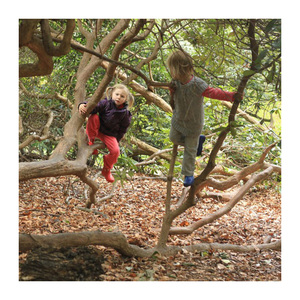 Written by Clare Caro Do you find yourself following your child to make sure they don’t trip and fall? Do you hear yourself yelling out warnings to “be careful” and “look where you’re going”? What about offering them a helping hand to get up, to climb, and to balance because that makes you feel safer when your child is undertaking something you have deemed as risky? Or perhaps your child is ‘shy’ and so you find yourself accompanying them everywhere. We always have good reasons when we chase, follow, call out, or hold our children’s hands. Yet unwittingly, these very behaviours of ours hinder our children stepping into the rich world of child-led play. “Children need space – or at least have the perception of having time away from adults. We all need time to relax, de-stress from the day, get creative, to ponder life, create a balance, and find joy. Children especially need this time to become independent and capable.” Angela Hanscom We need information and confidence to learn how to step back when we find ourselves in any of these ‘traditional support roles’. It is very easy to read, talk about, and agree with ‘taking a step back and observing your child at play’, but the transition to taking on a new support role while our child takes the lead in their own play - without us, can be very uncomfortable at first. After all, up until now we have spent a lot of time and focus on reading our little one’s cues and responding to their needs and wants by being there. How do we advance to the next level and learn to let go? How do we learn step back while making sure they are safe and secure? Our dual objective is to support our children should they really need us, and to support their unfolding autonomy at the same time. Needs, wants and autonomy combine to strike a fine balance. Like every balancing act, there is a lot of to-ing and fro-ing while children find their own feet in the world. Even though we have to let go and step back, it’s also important to know that we don’t ‘just leave them’. The pivotal ingredient in creating a safe environment for child-led play is you. When you learn to step back and let your child take the lead in their play, you also create the safe environment that your child requires to make play the optimum learning experience. An optimum learning play experience is an experience where there is no need for the child’s developing brain to go into alert. The more you learn to relax, get calm and present, the more the environment feels safer to those in your company. Your calm, relaxed emotional state allows your child the time and space to put all focus into their play. This is the reason some children will not leave the parent’s side until they have summed up the situation, before their readiness-meter says its okay to venture off. Other children head off straight away and only glance back now and then to check you are there. In all cases, you are the anchor to their feeling-of-safety. It is genetically coded into human children venturing into the world - and into their autonomy - to check back with you. One of the fastest ways to being a great supporter of child-led play is to become an observer. When you observe you create a safe environment by being there in an anchoring, non-intrusive way. At the same time you are nearby should you be required to step in. Being an observer also gives you the space to observe what is going on for you in this new support partnership with your child. Honing this respectful way of partnership-parenting early on makes other aspects of parenting easier. The ‘observing-tool’ works for all ages and stages of development. It is the most appropriate support you can offer whether your baby is deeply engaged in learning to use her hands or exploring. It is the most appropriate support when she is moving, crawling, manoeuvring over objects, and generally working on her balance. It is even the most appropriate support for older children learning how to communicate and negotiate over objects. Whatever the play, observing is a great way to support children in their play without getting involved - unless intervention is genuinely required, of course. Here are five easy steps to becoming an Observer. 1. Observers use their eyes.
2. Observers use their voice only when absolutely necessary.
3. Observers place themselves strategically.
4. Observers know about risk. Observers have sorted out the difference between a genuine risk and a hazard. They also have a growing understanding about the different types of play and developmental stages.
5. Observers have timing.
“When children are free to play, they play naturally at the ever-advancing edges of their mental and physical abilities...playing with other children, away from adults, is how children learn to make their own decisions, control their emotions and impulses, see from others’ perspectives, negotiate differences with others, and make friends. In short, play is how children learn to take control of their lives.” Peter Gray Pretty soon you will be an expert observer, always anchoring and always with one eye on the play. Nature Play - Take a step back and observe your child at play. ...take me back to the A R T I C L E S menu. |
|
Copyright © 2024 Nature Play
|

 RSS Feed
RSS Feed